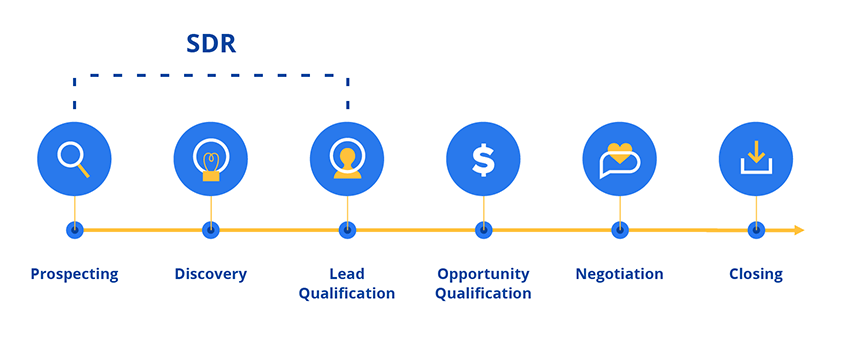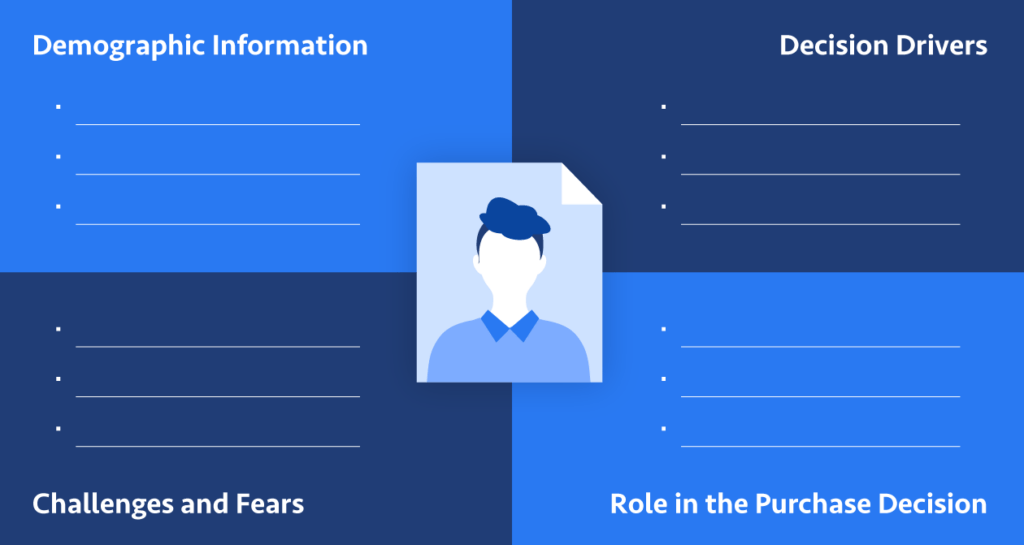Want to know the leading factor attributed to achieving your business revenue goals? According to Tribal Impact, it’s the strong alignment between your sales and marketing teams.
So if you’re experiencing business growth stagnation, then chances are, your sales and marketing teams do not have an effective partnership. But what are the other consequences of a misaligned sales and marketing team? How do you incentivize both teams to work closer together?
Perhaps the most important question to ask is why your business needs to start adapting an all-bound approach ASAP.
In this post, we’ll go over:
- 7 Sales and Marketing Alignment Statistics to Consider
- What is EBQ’s All-bound Approach?
- 7 tips for sales and marketing alignment

Download the Ultimate Guide to the B2B Buyer’s Journey
Download our guide to learn how to map out your ideal customer journey.
7 Sales and Marketing Alignment Statistics to Consider
If your sales and marketing leaders are resistant to a closer relationship, then your first step is to prove how much easier their lives would be with each other.
Studies show that organizations with strong sales and marketing alignment can:
Achieve more than 30% higher sales win rates (ZoomInfo)
Save 30% on customer acquisition costs (Beacon)
Reach 24% faster revenue growth (Conveyor)
Increase by 36% in customer retention rates (MarketingProfs)
Become 67% more effective in closing deals (Tribal Impact)
Achieve more than double your revenue from marketing alone (ZoomInfo)
Increase upsells and cross-sells by up to 20% (Gartner)
Translation: Strong relationships between sales and marketing teams lead to increased revenue growth and lowered costs.
With these top statistics in mind, let’s shift gears and explain how we’d recommend your business structure your sales and marketing efforts.
What is EBQ’s All-bound Approach?
Traditionally, business leaders often prefer a more siloed approach to department structure. Think about it: it’s almost easier to ask people to only focus on executing their assigned tasks.
However, that’s how misalignment happens. Did you know that only 1/3 of companies have regular standing meetings between their sales and marketing teams?
As a result, only 50% of companies say their sales and marketing teams have a standardized definition of what makes a qualified lead. Therefore, sales reps often ignore half of their marketing leads. That has to be frustrating for both the sales and marketing teams.
At EBQ, we emphasize the importance of utilizing an all-bound approach. An all-bound approach is when you consider all aspects of sales and marketing leads — both inbound and outreached — and develop a standardized customer journey for them.
Your first step is to sit your sales and marketing leaders down and evaluate your B2B Buyer’s Journey together. You should answer the following questions:
- What do your buyer personas look like?
- How do they first hear about your brand?
- When is a lead considered a marketing-qualified lead (MQL)?
- When is a lead considered a sales-qualified lead (SQL)?
- What does your average sales cycle look like?
- How do you ensure a high customer retention rate?

Download the Ultimate Guide to the B2B Buyer’s Journey
Download our guide to learn how to map out your ideal customer journey.
From there, we’ll dive into how you can strengthen the relationship between your sales and marketing teams.
7 Tips for Sales and Marketing Alignment
Based on our 15+ years of experience, here are 10 ways to better the partnership between your sales and marketing teams.
1. Build an Appointment-Setting Team
In short, the appointment-setting team is responsible for the first quarter of the sales cycle. The team is made up of sales development reps (SDRs), who are responsible for nurturing all colder leads into sales-ready leads.
From our experience, an SDR team helps bridge the gap between sales and marketing by helping both teams follow up on cold leads.

How this benefits your Sales team:
Studies show that 40% of salespeople consider prospecting the most challenging aspect of the job. It’s often disheartening to have to face so many rejections — all while trying to pay close attention to warm leads that are close to cutting a deal.
If you rely on your salespeople to follow up on inbound marketing leads — all while negotiating and closing deals — your sales team will inevitably reach burnout.
By taking prospecting and lead nurturing off of their plates, your sales team can effectively close more deals from your marketing team’s efforts. In that sense, the SDR/AE model is crucial to strengthening sales teams.
How this benefits your Marketing team:
You can expect that more than 75% of all marketing leads never convert. That might explain why barely 60% of marketers are sending all their leads to sales — as they’re often vetting these leads themselves.
By creating a sales development team, your marketing team can afford to send all of their leads to a designated team who are focused on further nurturing these prospects. That way, the marketing team can focus on creating increasingly effective marketing campaigns to drive more leads down the sales funnel.
If you’re looking to create your own SDR team, consider outsourcing with EBQ. Since 2006, we’ve been sales development leaders who specialize in blending our proven processes with both niche and mass industries — all for a fraction of the cost of hiring internally.
2. Use the Same CRM
A customer relationship management (CRM) system — like Salesforce — is a robust tool that ensures all your customer data is stored in one system. Then, each department can utilize the same data differently to suit their needs.

Interested in learning more about CRM? We’ve written The Beginner’s Guide to CRM which goes over how to get started and how to evaluate your team’s success from a single pane of glass.
How this benefits your Sales team:
Did you know that inaccurate B2B data wastes more than 25% of your sales rep’s time? This means that even the most seasoned salesperson can run into the risk of chasing down the wrong lead — all because of misinformation.
A CRM can solve this problem: they’re designed to unify all customer data from the initial contact point to conversion. By tracking each touch point, your sales team can have a full understanding of the decision drivers that attracted them to your solution.
That way, they can better prepare for future sales calls.
How this benefits your Marketing team:
Using marketing automation software allows you to reach more people more effectively — assuming you feed the instance with the right data.
If your sales and marketing team use the same CRM, your marketers can evaluate the impact of their campaigns on your overall sales funnel and optimize their outreach efforts. From there, they can make stronger data-driven decisions in the future.
3. Align Your Buyer Persona
As mentioned previously, you’ll want to align your buyer personas with your sales and marketing teams. If you want your teams to be prepared for each touchpoint, then they’ll need to understand exactly who they’re targeting, what motivates them to convert, and how to approach these leads.

To help you get started, check out “10 Components of a Well-Defined B2B Buyer Persona.” We go over key details you need to know about your prospects before your sales and marketing teams continue to invest time in nurturing them.
4. Strengthen Your Content Marketing
An alarming survey shows that up to 70% of B2B content is not used properly. Therefore, most marketing professionals believe that the sales team is not properly utilizing their content to better CRM.
On the other hand, 65% of sales reps say they can’t find relevant content to send to prospects for further nurturing.
Therefore, content marketing is the key to better aligning your sales and marketing teams.
By doing so, studies also show that companies can achieve 73% higher conversion rates if their content strategy is aligned with the specific stages of the buyer’s journey.
Start by evaluating all of your sales collateral. Are they following best practices? Do they speak to a specific stage of the buyer’s journey? Are they well-written and properly branded?
From there, be sure to use a Knowledge Base system — such as Google Workspace. Make sure each collateral piece is properly labeled and easy to find for your sales team. We also recommend creating an inventory list that summarizes each content piece, which solution you’re promoting, and relevant links for quick downloads.
5. Facilitate Training
Now that your sales and marketing leaders are aligned in processes and definitions, it’s time to disseminate that information to your specialists.
By training both your sales and marketing specialists, they’ll be able to truly understand each other’s functions and shared goals to look for further opportunities to improve their processes.
If you’re using a singular CRM, you’ll need to pay close attention to make sure everyone knows how to properly utilize the shared tool. Otherwise, you risk polluting your instance with irregular data. For more tips, be sure to check out our blog post on “Training Employees to Use Salesforce.”
6. Meet Regularly and Encourage Open Feedback
Everyone has room for improvement, so it’s pertinent to facilitate a collaborative environment that empowers both sales and marketing teams to give each other feedback.
For sales and marketing to align properly, regular meetings are essential. These meetings should create open dialogue, align goals, solve problems, provide feedback, and strengthen relationships within your organization.
We recommend that your sales and marketing team should meet at least once a quarter. These meetings should discuss both your progress and any additional new insights your team collected through their sales or marketing efforts.
7. Utilize Customer Feedback
Leveraging customer feedback can help align your sales and marketing teams because it can help inform your entire customer journey thus far. Through these comments, both your teams can identify ways to improve your future customer experience.
If you’re looking for actionable insights on how to create loyal brand advocates, check out The Ultimate Guide to B2B Customer Service Strategy. There, we go over how to build an effective customer service team and best practices.
Marketing and Sales Alignment for Improved Effectiveness
One of the key challenges faced by any B2B organization is sales and marketing misalignment. Historically, these two departments have operated in silos, often working towards separate goals and objectives.
However, utilizing EBQ’s all-bound strategy is key to a stronger partnership between sales and marketing — ultimately leading to an increase in revenue growth.
If you have any additional questions or insights you’d like to share, feel free to reach out to one of our Business Consultants. We look forward to working with you and growing your business.



